The Dry Electrostatic Precipitator Market is estimated at USD 8.4 billion in 2025 and is projected to reach USD 15.2 billion by 2035, reflecting a CAGR of 6.1%. Scenario-based forecasting provides a structured view of how market dynamics may evolve under varying adoption and regulatory conditions. In the base case scenario, gradual enforcement of emission control standards and steady industrial expansion support consistent market growth from USD 8.4 billion in 2025 to USD 15.2 billion in 2035.
Year-on-year growth remains stable, driven primarily by ongoing replacement of legacy systems and moderate adoption of enhanced dry ESP technologies. In an aggressive scenario, accelerated implementation of stricter environmental regulations, rapid industrialization in emerging economies, and increased investments in air pollution control technologies push adoption ahead of base projections.
Under this scenario, demand grows more rapidly in early years, resulting in market values exceeding USD 10 billion by 2030 and reaching the upper range of forecasts before 2035. Advanced ESP designs offering higher collection efficiency and lower operational costs would gain a larger share of installations, reinforcing accelerated revenue growth. A conservative scenario may emerge if regulatory enforcement is delayed or capital expenditures are constrained, slowing adoption and delaying replacements.
In this case, the market would track below the base projection, with slower year-on-year increments and reduced investment in modernization. The scenario-based forecasting highlights the critical influence of policy, industrial activity, and technological adoption on the Dry Electrostatic Precipitator Market over 2025–2035.
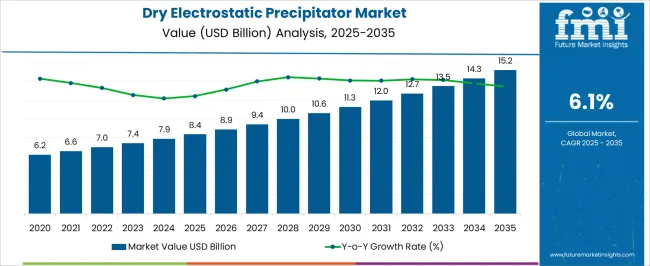
| Metric | Value |
|---|---|
| Dry Electrostatic Precipitator Market Estimated Value in (2025 E) | USD 8.4 billion |
| Dry Electrostatic Precipitator Market Forecast Value in (2035 F) | USD 15.2 billion |
| Forecast CAGR (2025 to 2035) | 6.1% |
The dry electrostatic precipitator market is progressing steadily as industries focus more on controlling particulate emissions and meeting stricter environmental regulations. Increased awareness of air pollution and its health impacts has driven demand for efficient air pollution control technologies.
Power generation facilities, being major sources of particulate matter, have become primary users of dry electrostatic precipitators to reduce emissions and comply with environmental standards. Advances in precipitator design have improved collection efficiency and operational reliability, making these systems more attractive for industrial applications.
Growing industrialization and the expansion of power plants globally are further supporting market growth. Future opportunities are expected as governments tighten emission norms and industries adopt cleaner production processes. Segmental growth is expected to be led by the Plate design type, due to its proven effectiveness, and the Power Generation sector, which requires large-scale particulate control solutions.
The dry electrostatic precipitator market is segmented by design, emitting industry, and geographic regions. By design of the dry electrostatic precipitator market is divided into Plate and Tubular. In terms of emitting industry of the dry electrostatic precipitator market is classified into Power generation, Chemicals and petrochemicals, Cement, Metal Processing & mining, Manufacturing, Marine, and Others. Regionally, the dry electrostatic precipitator industry is classified into North America, Latin America, Western Europe, Eastern Europe, Balkan & Baltic Countries, Russia & Belarus, Central Asia, East Asia, South Asia & Pacific, and the Middle East & Africa.
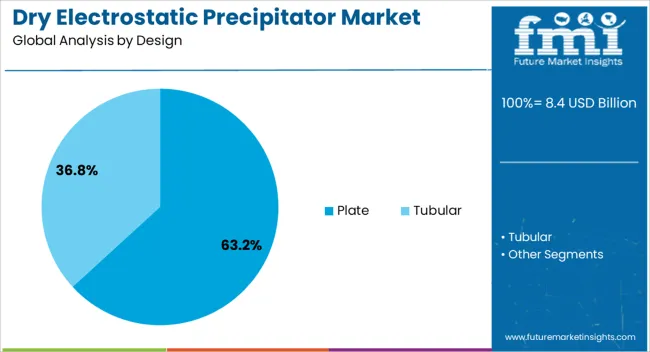
The Plate design segment is expected to account for 63.2% of the dry electrostatic precipitator market revenue in 2025, maintaining its dominance in design types. This segment’s growth is driven by the widespread use of plate-type precipitators in power plants and heavy industries.
Plate designs offer reliable performance in capturing fine particulate matter from flue gases. Their ability to handle large gas volumes and maintain efficiency over long operating periods makes them preferred in continuous industrial operations.
Additionally, the simplicity of maintenance and robustness of plate designs contribute to their sustained market preference. The proven technology and adaptability to different industrial conditions have helped this segment remain at the forefront of the market.
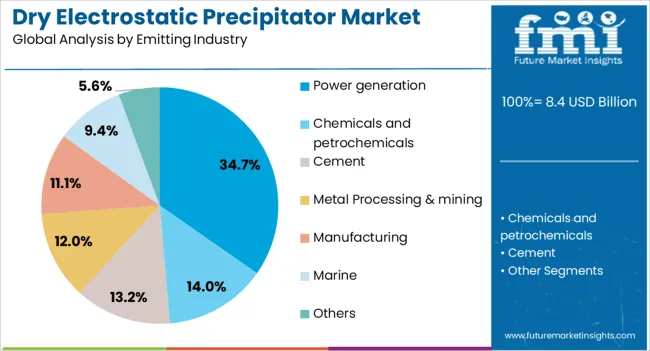
The Power Generation segment is projected to hold 34.7% of the dry electrostatic precipitator market revenue in 2025, securing its position as the leading emitting industry segment. This segment’s growth is largely attributed to the high volume of particulate emissions generated by coal-fired and thermal power plants.
Regulatory mandates focused on reducing air pollution from power generation have necessitated the adoption of effective emission control technologies such as dry electrostatic precipitators. Power plants require scalable and efficient particulate removal solutions to meet environmental compliance while maintaining operational efficiency.
The ongoing modernization of older power generation facilities and construction of new plants are also increasing demand. As the power generation sector continues to prioritize emission reduction strategies, the segment is expected to remain a key driver of market growth.
The market has been expanding due to the increasing need for air pollution control in industrial and power generation sectors. These systems have been widely utilized to remove particulate matter from flue gases, ensuring compliance with environmental standards and improving operational efficiency. Market growth has been supported by technological advancements, energy-efficient designs, and rising industrial emissions control awareness. The deployment of dry ESPs has been further strengthened by stringent emission regulations, growing power generation capacity, and the push for cleaner industrial operations globally.
Industrial and power generation sectors have been primary drivers of the dry ESP market due to the need to reduce particulate emissions and improve air quality. Dry ESPs have been utilized in coal-fired power plants, cement manufacturing units, steel mills, and chemical processing facilities to capture fine dust and ash from exhaust gases. Their ability to operate at high temperatures and handle large gas volumes has made them preferable for industrial applications. The demand for efficient, low-maintenance, and long-life filtration systems has further strengthened adoption. Additionally, rapid industrialization, expansion of thermal power plants, and growing environmental awareness have reinforced the importance of dry ESPs. These systems have been considered essential for compliance with emission norms, operational reliability, and sustainable industrial practices worldwide.
Technological improvements in dry ESPs have increased efficiency, reliability, and energy savings. High-voltage transformers, advanced collecting electrodes, and optimized gas flow designs have enhanced particulate capture rates while reducing energy consumption. Real-time monitoring, automated cleaning systems, and adaptive voltage control have enabled consistent performance under varying operational conditions. Innovations in materials and corrosion-resistant coatings have improved durability in high-temperature and chemically aggressive environments. Modular designs and compact layouts have facilitated easy installation and maintenance. These advancements have made dry ESPs more suitable for diverse industrial applications, improving operational efficiency, minimizing downtime, and ensuring compliance with stringent environmental standards. Enhanced technological performance has therefore driven broader adoption across power generation and heavy industry sectors globally.
Stringent environmental regulations have been a major factor influencing the adoption of dry ESPs. Industrial and power generation facilities have been required to limit particulate emissions to meet air quality standards and reduce health and environmental impacts. Automated monitoring and reporting capabilities of modern dry ESPs have supported regulatory compliance and operational transparency. Failure to comply has resulted in penalties, production restrictions, or operational delays, prompting industries to invest in advanced emission control systems. Additionally, environmental sustainability initiatives and corporate social responsibility commitments have reinforced the importance of installing dry ESPs. By providing effective dust collection, operational efficiency, and adherence to environmental standards, these systems have become critical components in industrial emission control strategies globally.
The focus on energy efficiency and sustainable industrial operations has created significant growth opportunities for the dry ESP market. Low-energy consumption designs, optimized electrode configurations, and improved gas flow dynamics have reduced operational costs while maintaining high collection efficiency. Integration with renewable energy facilities, waste-to-energy plants, and hybrid power systems has further increased applications. The demand for modular, compact, and easily maintainable ESP units has risen with the expansion of small-scale industrial facilities and decentralized power generation. Additionally, the push for greener industrial practices and emission reduction targets in emerging economies has created new avenues for market expansion. Energy-efficient and environmentally friendly dry ESP solutions are expected to see continued adoption in global industrial and power generation sectors.

The market is anticipated to grow at a CAGR of 6.1% between 2025 and 2035, driven by increasing industrial emission control regulations, adoption of advanced particulate removal technologies, and integration of energy-efficient systems. China leads with an 8.2% CAGR, supported by stringent environmental policies and large-scale industrial operations. India follows at 7.6%, with growth fueled by rising power generation and industrialization. Germany, at 7.0%, benefits from strict emission norms and advanced technological adoption. The UK, growing at 5.8%, focuses on industrial pollution mitigation and energy efficiency, while the USA, at 5.2%, experiences steady deployment in power and manufacturing sectors. This report includes insights on 40+ countries; the top markets are shown here for reference.
The dry electrostatic precipitator industry in China is projected to expand at a CAGR of 8.2% from 2025 to 2035, fueled by growing industrial emissions control initiatives and regulatory compliance requirements. Manufacturing and power generation sectors are increasingly adopting dry ESP systems to reduce particulate matter emissions. Integration with advanced monitoring and automation solutions is improving operational efficiency and reliability. Key manufacturers are focusing on modular designs to cater to varying plant capacities. Industrial pollution control programs and government incentives are further accelerating market adoption.
The Indian market is forecast to grow at a CAGR of 7.6%, driven by rising environmental regulations and industrial expansion. Industries such as cement, steel, and power are increasingly implementing dry ESP solutions to reduce particulate emissions. Local manufacturers are emphasizing compact, energy-efficient systems to meet plant-specific requirements. Collaboration with technology providers for IoT-enabled monitoring is improving system efficiency. Government incentives for cleaner energy plants are supporting adoption. Industrial demand for sustainable emission reduction solutions is expected to strengthen growth over the coming decade.
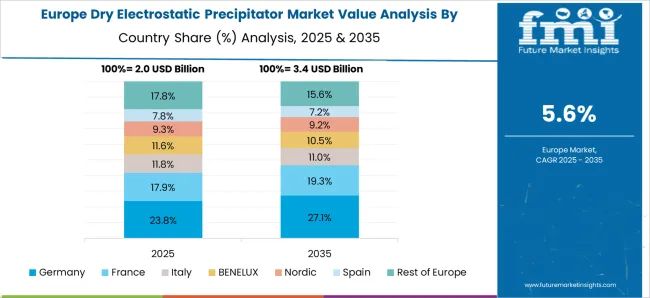
Germany is anticipated to expand at a CAGR of 7.0% due to stringent emission norms and high adoption in power generation and chemical industries. Advanced dry ESP systems with low maintenance requirements are preferred by industrial operators. Integration with automated control systems and real-time monitoring is enhancing particulate removal efficiency. Strategic partnerships between equipment manufacturers and industrial clients are supporting tailored solutions. Demand for compact and modular designs is growing to address space constraints in urban industrial plants.
The United Kingdom is projected to grow at a CAGR of 5.8%, driven by industrial and utility sector initiatives for particulate emission reduction. Companies are focusing on high-efficiency dry ESP systems compatible with existing infrastructure. Real-time data monitoring and predictive maintenance are becoming standard for reducing operational downtime. Demand is supported by regulatory compliance and environmental protection programs. Strategic collaborations with European technology providers are facilitating the deployment of advanced precipitator systems.
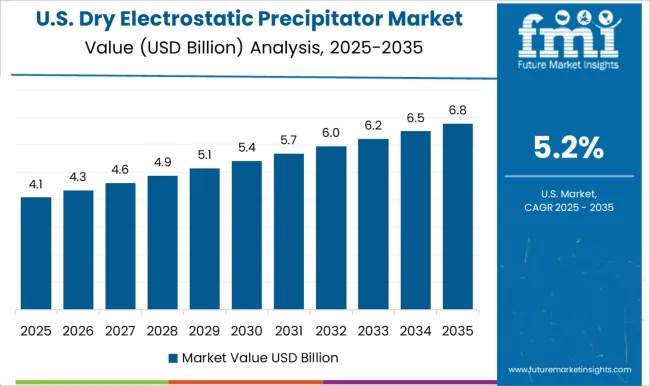
The United States market is expected to grow at a CAGR of 5.2% due to increasing industrial emission control requirements and modernization of existing plants. Adoption of advanced dry ESP solutions is being driven by the power generation, cement, and chemical manufacturing sectors. Companies are investing in energy-efficient and low-maintenance systems with automated monitoring capabilities. The growing focus on environmental compliance and operational cost reduction is supporting market expansion. Collaboration with technology vendors is enhancing system performance and reliability.
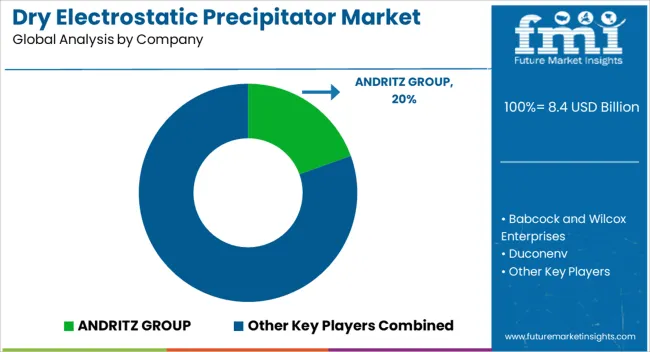
The market is shaped by the need for industrial emission control, particularly in power generation, cement, steel, and chemical sectors. ANDRITZ Group leads with solutions offering high collection efficiency and tailored designs for large-scale applications. Babcock and Wilcox Enterprises combines engineering expertise with custom ESP systems for power plants and heavy industries, while Duconenv delivers modular solutions optimized for particulate removal and minimal operational downtime.
DURR Group focuses on integrated flue gas cleaning systems, combining ESPs with auxiliary pollution control technologies. Enviropol Engineers provides localized, cost-effective ESP designs for emerging industrial markets, and GEA Group Aktiengesellschaft offers solutions emphasizing energy efficiency and low maintenance requirements. KC Cottrell India serves both domestic and international markets with turnkey ESP systems, while Mitsubishi Heavy Industries leverages advanced materials and design techniques to enhance particulate capture.
PPC Industries and Siemens Energy integrate ESPs into broader emission control systems for industrial clients. Sumitomo Heavy Industries and Thermax focus on high-capacity, reliable ESPs for power and cement sectors, whereas TAPC, WEIXIAN, and Wood deliver specialized systems for niche industrial processes.
Market entry is restricted by technical expertise requirements, adherence to environmental regulations, and high capital investment for large-scale installations. Companies combining durability, performance, and regulatory compliance maintain a competitive edge and are positioned for sustained growth.
| Item | Value |
|---|---|
| Quantitative Units | USD Billion |
| Design | Plate and Tubular |
| Emitting Industry | Power generation, Chemicals and petrochemicals, Cement, Metal Processing & mining, Manufacturing, Marine, and Others |
| Regions Covered | North America, Europe, Asia-Pacific, Latin America, Middle East & Africa |
| Country Covered | United States, Canada, Germany, France, United Kingdom, China, Japan, India, Brazil, South Africa |
| Key Companies Profiled | ANDRITZ GROUP, Babcock and Wilcox Enterprises, Ducon Environmental Systems, Dürr Group, Enviropol Engineers, GEA Group Aktiengesellschaft, KC Cottrell India, Mitsubishi Heavy Industries, PPC Industries, Siemens Energy, Sumitomo Heavy Industries, Thermax, TAPC, Wood |
| Additional Attributes | Dollar sales by precipitator type and end-use industry, demand dynamics across power generation, cement, steel, and waste incineration sectors, regional trends in deployment across North America, Europe, and Asia-Pacific, innovation in high-efficiency electrode designs, low-maintenance configurations, and digital monitoring systems, environmental impact of particulate emission reduction, energy consumption, and electrode material disposal, and emerging use cases in industrial air quality compliance, carbon capture integration, and retrofitting for renewable energy facilities. |
The global dry electrostatic precipitator market is estimated to be valued at USD 8.4 billion in 2025.
The market size for the dry electrostatic precipitator market is projected to reach USD 15.2 billion by 2035.
The dry electrostatic precipitator market is expected to grow at a 6.1% CAGR between 2025 and 2035.
The key product types in dry electrostatic precipitator market are plate and tubular.
In terms of emitting industry, power generation segment to command 34.7% share in the dry electrostatic precipitator market in 2025.






Our Research Products

The "Full Research Suite" delivers actionable market intel, deep dives on markets or technologies, so clients act faster, cut risk, and unlock growth.

The Leaderboard benchmarks and ranks top vendors, classifying them as Established Leaders, Leading Challengers, or Disruptors & Challengers.

Locates where complements amplify value and substitutes erode it, forecasting net impact by horizon

We deliver granular, decision-grade intel: market sizing, 5-year forecasts, pricing, adoption, usage, revenue, and operational KPIs—plus competitor tracking, regulation, and value chains—across 60 countries broadly.

Spot the shifts before they hit your P&L. We track inflection points, adoption curves, pricing moves, and ecosystem plays to show where demand is heading, why it is changing, and what to do next across high-growth markets and disruptive tech

Real-time reads of user behavior. We track shifting priorities, perceptions of today’s and next-gen services, and provider experience, then pace how fast tech moves from trial to adoption, blending buyer, consumer, and channel inputs with social signals (#WhySwitch, #UX).

Partner with our analyst team to build a custom report designed around your business priorities. From analysing market trends to assessing competitors or crafting bespoke datasets, we tailor insights to your needs.
Supplier Intelligence
Discovery & Profiling
Capacity & Footprint
Performance & Risk
Compliance & Governance
Commercial Readiness
Who Supplies Whom
Scorecards & Shortlists
Playbooks & Docs
Category Intelligence
Definition & Scope
Demand & Use Cases
Cost Drivers
Market Structure
Supply Chain Map
Trade & Policy
Operating Norms
Deliverables
Buyer Intelligence
Account Basics
Spend & Scope
Procurement Model
Vendor Requirements
Terms & Policies
Entry Strategy
Pain Points & Triggers
Outputs
Pricing Analysis
Benchmarks
Trends
Should-Cost
Indexation
Landed Cost
Commercial Terms
Deliverables
Brand Analysis
Positioning & Value Prop
Share & Presence
Customer Evidence
Go-to-Market
Digital & Reputation
Compliance & Trust
KPIs & Gaps
Outputs
Full Research Suite comprises of:
Market outlook & trends analysis
Interviews & case studies
Strategic recommendations
Vendor profiles & capabilities analysis
5-year forecasts
8 regions and 60+ country-level data splits
Market segment data splits
12 months of continuous data updates
DELIVERED AS:
PDF EXCEL ONLINE
Dry Electrostatic Wipes Market Size and Share Forecast Outlook 2025 to 2035
Electrostatic Precipitator Market Growth - Trends & Forecast 2025 to 2035
Wet Electrostatic Precipitator Market Size and Share Forecast Outlook 2025 to 2035
Plate Electrostatic Precipitator Market Size and Share Forecast Outlook 2025 to 2035
Power Generation Electrostatic Precipitator Market Size and Share Forecast Outlook 2025 to 2035
Manufacturing Scale Electrostatic Precipitator Market Size and Share Forecast Outlook 2025 to 2035
Chemicals And Petrochemicals Electrostatic Precipitator Market Size and Share Forecast Outlook 2025 to 2035
Dry-type Air-core Smoothing Reactor Market Size and Share Forecast Outlook 2025 to 2035
Electrostatic Coating Stations Market Size and Share Forecast Outlook 2025 to 2035
Dry Powder Inhaler Market Size and Share Forecast Outlook 2025 to 2035
Dry Vacuum Pumps Market Size and Share Forecast Outlook 2025 to 2035
Dry Cleaning Solvents Market Size and Share Forecast Outlook 2025 to 2035
Dry Block Heaters Market Size and Share Forecast Outlook 2025 to 2035
Dry Fog Dust Suppression Equipment Market Size and Share Forecast Outlook 2025 to 2035
Dry Scalp Treatment Market Size and Share Forecast Outlook 2025 to 2035
Dry Type Distribution Transformer Market Size and Share Forecast Outlook 2025 to 2035
Dry Type Current Transformer Market Size and Share Forecast Outlook 2025 to 2035
Dry Eye Syndrome Treatment Market Size and Share Forecast Outlook 2025 to 2035
Dry Type Automated Solar Panel Cleaning Market Size and Share Forecast Outlook 2025 to 2035
Dry Herb Cannabis Vaporizers Market Size and Share Forecast Outlook 2025 to 2035

Thank you!
You will receive an email from our Business Development Manager. Please be sure to check your SPAM/JUNK folder too.
Chat With
MaRIA